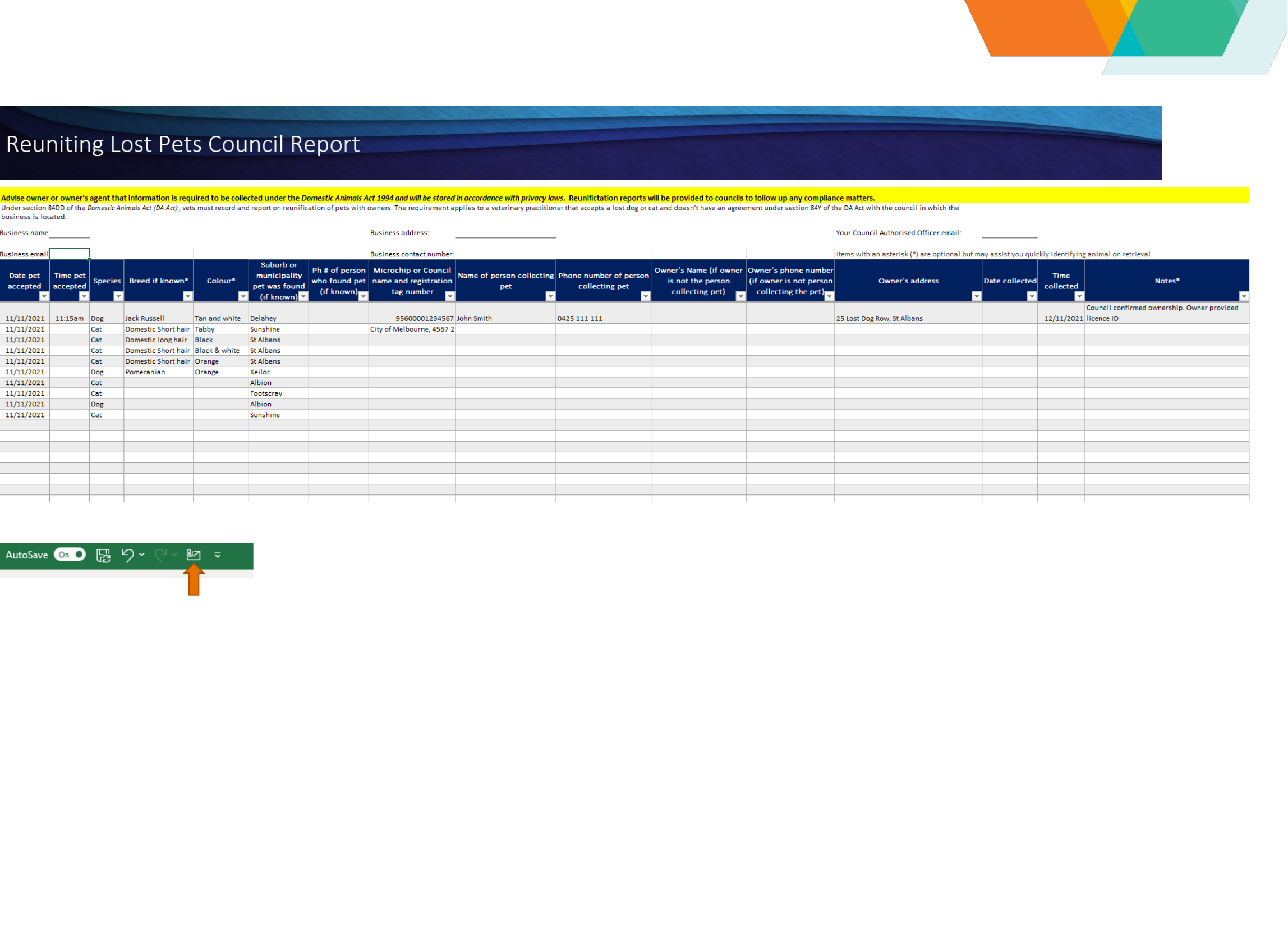
1
OFFICIAL
Reuniting Lost Pets implementation kit:
Guidance for veterinarians
Contents
1. Purpose ........................................................................................................................................ 2
2. Changes to reuniting lost pets .................................................................................................. 2
3. Getting involved .......................................................................................................................... 4
3.1 Determing whether to accept a lost pet or relinquish it to council ......................................... 4
What if the cat or dog has no microchip or council registration tag? ............................................ 5
Which council do I contact? .......................................................................................................... 5
What if council doesn’t have any registration information for a lost pet? ...................................... 5
What if council will not collect a lost pet from my clinic? ............................................................... 5
3.2 Accepting a lost pet ............................................................................................................... 5
Can I accept lost pets found outside of my local council/ municipality? ....................................... 6
Do I have to collect the details of the person who found the pet or where they found it? ............ 6
Can council fine a pet owner if their lost pet is at large, not registered or desexed? ................... 6
3.3 Pet identification .................................................................................................................... 6
What constitutes a reasonable effort to contact council to verify ownership? .............................. 7
What if I don’t get a response from council? ................................................................................. 7
What do I do if a cat or dog’s microchip information is not consistent with the council registration
information?................................................................................................................................... 7
What do I do if the pet is microchipped but is not registered with council? .................................. 7
3.4 Pet reunification .................................................................................................................... 7
3.5 Collection of information ........................................................................................................ 8
4. Record keeping and reporting ................................................................................................... 8
4.1 Working with local councils ................................................................................................... 9
5. Reunification fee ......................................................................................................................... 9
Further Information ........................................................................................................................... 10
Appendix 1: Checklist for reunification and reporting process ................................................... 11
Appendix 2: Sample animal collection form .................................................................................. 13
Appendix 3: Sample excel reporting template available online ................................................... 14

2
OFFICIAL
1. Purpose
This guide is designed to assist vets in delivering reforms introduced by the Domestic
Animals Amendment (Reuniting Pets and Other Matters) Act 2022 (RP Act).
Guidance is provided on:
• changes to the reuniting pets process
• implementation of ownership verification, pet recovery and reporting requirements
A series of FAQs tailored to vets is also included throughout this document, to assist
interpretation of legislative changes.
Please note that the reuniting lost pet reforms, and guidance in this document, do not apply
to vets with existing 84Y agreements with council/s. Where 84Y agreements are in place,
the terms and conditions set out in those agreements continue to apply.
2. Changes to reuniting lost pets
The RP Act introduced a range of changes to the Domestic Animals Act 1994 (DA Act).
These changes deliver the Victorian Government’s election commitment to allow vets and
registered animal shelters (shelters) to directly reunite lost cats and dogs (herein referred to
as pets) with their owners.
Under the amended DA Act, shelters and participating vets will be able to reunite lost pets
with their owners more efficiently. That is, the requirement to hold a written agreement with
local council under section 84Y of the DA Act has been removed for the purpose of
reuniting lost pets.
Prior to these reforms, only vet clinics with an 84Y agreement with council were permitted
to accept a lost dog or cat delivered to them.
From 1 October 2022, a person (other than a council authorised officer) who finds a lost dog
or cat can take it to:
• a council authorised officer within the municipality where the pet was found
• a person or body that has an 84Y agreement with that council
• a person or body that conducts an animal shelter that does not hold an 84Y
agreement with that Council
• a participating local vet that does not hold an 84Y agreement with that Council, and
consents to receiving the pet.
See the following diagram outlining the process for reuniting lost pets.

3
OFFICIAL

4
OFFICIAL
3. Getting involved
Providing lost pet reunification services is not mandatory for vets; if you or your clinic is
unable or unwilling to provide this service, members of the public can be referred to
other participating vets, shelters, or to council.
Vets are encouraged to reach out to their council to advise whether they intend to
reunite lost pets. If so, it will be beneficial to agree on a communications process
between you and your council, to ensure timely ownership verification or pet collection (if
the pet must be relinquished to council).
How will people know if I am involved in reuniting lost pets?
You may choose to display information at their entry to advise members of the public
that they accept lost pets for reunification. You could also inform their clients or post
information on social media.
Animal Welfare Victoria (AWV) is also advising the community that if they find a lost pet
and wish to drop it off at a vet clinic, they should phone the vet clinic prior to delivering
the lost pet to confirm whether they will accept the animal for reunification.
What is the best way to contact council?
To access council contact details, enter your suburb or postcode on this website:
https://knowyourcouncil.vic.gov.au/councils. This will provide you with a contact number
and email address for your council.
3.1 Determing whether to accept a lost pet or relinquish it to
council
The circumstances in which lost pets must be relinquished to council relate primarily to
public safety, uncertain ownership and animal welfare. Lost pets must go to council if:
• there are concerns about the health or welfare of the pet (e.g. it has been
neglected). This is to ensure that council can follow up welfare concerns directly
with owners and other animal welfare agencies if necessary.
• a vet reasonably suspects it is a dangerous, menacing or restricted breed dog.
Victorian Declared Dog Registry information is reflected in microchip registry
databases, so vets are able to identify declared dogs.
• a vet reasonably suspects the dog has been involved in a dog attack.
• a vet cannot identify the owner within 24 hours of receiving the pet, or cannot
contact the owner in a reasonable time.
• the owner or their agent does not collect the pet within the agreed recovery
period.
Lost pets must also be relinquished to council under any other circumstances prescribed
in the Domestic Animals Regulations 2015 (DA Regulations). This provision allows the
government to adjust the law if stakeholders over time determine there are other
circumstances when pets should be relinquished to council.
Note: no further circumstances have been prescribed at this stage.

5
OFFICIAL
Refer to section 84DB of the DA Act.
What if the cat or dog has no microchip or council registration tag?
The reunification scheme only applies to lost pets with some form of ownership
identification (microchip or council registration tag). If a pet does not have a microchip,
council tag or any other form of identifying information, it must be relinquished to council.
Which council do I contact?
In most cases, the pet will be from your municipality, so calling your local council should
be sufficient. However, if you scan the pet’s microchip and it brings up a suburb in
another council, you can either contact that council to verify ownership or just relinquish
the pet to your local council.
To identify the council for a particular suburb, enter the suburb that appears on the
microchip details here https://knowyourcouncil.vic.gov.au/councils.
What if council doesn’t have any registration information for a lost pet?
In this situation, you may reunite the lost pet with the person listed on the microchip
registry, only if they can prove to your satisfaction that they are the current owner (or
the owner’s agent, i.e. someone with authority to act on behalf of the owner). Evidence
to prove ownership may include a recent vet bill, for example.
What if council will not collect a lost pet from my clinic?
AWV is encouraging councils to develop a working relationships with vets in their
municipality intending to provide lost pet reunification services.
Vets are also encouraged to reach out to their council to advise whether they intend to
reunite lost pets. If so, agreeing on a communications process between you and your
council will assist timely ownership verification or pet collection. Developing relationships
and agreed processes will benefit the welfare of the pet, identify practical solutions and
assist with compliance.
3.2 Accepting a lost pet
If a lost pet is delivered to you and you choose to accept it, you will need to:
• Scan the pet within 12 hours of accepting it.
• Determine whether the pet must be relinquished to council (as per section 3.1,
note dangerous dogs should also wear a distinct red/yellow collar).
• Make a reasonable attempt to contact your local council to compare microchip
information against its pet registration data.
• Identify the pet’s owner within 24 hours of accepting the pet (through the
microchip record or council registration data/tag).
• After identifying the owner, contact them as soon as you can to collect their pet.
Nominate or agree to a recovery period within which the pet must be collected.
The recovery period is the first 24 hours since the pet was received by the vet,
the period nominated by the vet, or a period agreed between the vet and the
owner.

6
OFFICIAL
• The pet owner or their agent (e.g. family member, relative, friend) can recover
the pet within the agreed recovery period. If you are unable to verify ownership
with council, you must request that the pet owner or their agent brings evidence
of pet ownership. Before handing over the pet, you must be satisfied that the
person collecting the pet is the lawful owner, or their agent.
• Record details regarding the lost pet and who collected it.
• Report quarterly to council on the pets reunited with owners. No report is
required if there were no reunifications in a given reporting period.
Refer to section 84DA of the DA Act.
A process checklist to step you through the practical elements of the reunification
process is available at Appendix 1..
Can I accept lost pets found outside of my local council/ municipality?
Vets may accept a lost pet from another council area.
Do I have to collect the details of the person who found the pet or where they
found it?
You are encouraged to collect contact details of the person who delivered the pet, if they
are willing to provide this information. While collection of this information is not
mandatory, it will assist councils to follow up any ownership, investigative or compliance
matters.
Can council fine a pet owner if their lost pet is at large, not registered or desexed?
Councils are empowered to determine appropriate compliance actions if breaches to the
DA Act or regulations are identified. Councils may choose educate pet owners of their
legislative obligations before issuing fines, particularly if they have not previously
interacted with an individual. Compliance activities may also include warnings, or fines,
depending on the offence and circumstances.
3.3 Pet identification
Upon accepting a lost pet, you must scan the animal for a microchip within 12 hours and
take steps to identify the owner. Vets may also refer to the council registration tag to
confirm ownership information. If the pet is a greyhound, contacting Greyhound Racing
Victoria to confirm microchip information may also be required if no result is obtained at
petaddress.com.au
Microchip registry information may not always be up to date, as owners sometimes
forget to update details when pet ownership is transferred. As council registration is
renewed on an annual basis, vets must make a reasonable effort to contact council
to verify pet ownership. Registration data may provide a more accurate or current data
set and ensure the pet is returned to its lawful owner.
The Victorian Government will run an advertising campaign to remind owners to update
their pet’s ownership information (both with councils and microchip registries) as part of
reform implementation.

7
OFFICIAL
Note: Vets can only reunite lost pets that have some form of ownership identification. If
a pet does not have a microchip, council tag or any other form of identifying information,
it must be relinquished to council (as per section 3.1 question – What if the cat or dog
has no microchip or council registration tag?).
Refer to section 63J(1A), 84DB of the DA Act.
What constitutes a reasonable effort to contact council to verify ownership?
A reasonable effort would include a phone call or email to council’s domestic animal
management area during business hours, or contacting council’s after-hours ranger
service (if available).
What if I don’t get a response from council?
If you have made a reasonable effort to contact council but have been unsuccessful, you
can continue to reunite the pet using the microchip registry or council tag information.
The owner or their agent will be required to satisfy you that they are the owner (or were
sent by the owner) by providing some form of proof of ownership. This could be a recent
council registration renewal, vet bill or other proof.
What do I do if a cat or dog’s microchip information is not consistent with the
council registration information?
If the pet’s microchip owner details do not match council registration data, and you have
doubt over legal ownership, you must relinquish the pet to council to resolve ownership
contradictions.
What do I do if the pet is microchipped but is not registered with council?
You can continue to reunite the pet using the microchip registry information. The owner
or their agent will be required to satisfy you that they are (or represent) the lawful owner,
by providing some form of proof of ownership. If you are not satisfied they are the
owner, or their agent, then the pet must be relinquished to council.
3.4 Pet reunification
If you have been able to identify the pet’s owner within 24 hours of accepting the pet,
you must contact the owner as soon as possible to advise them to collect their pet.
If you are unable to verify ownership with council, you must request that the pet owner
or their agent brings evidence of pet ownership. Before reuniting the pet, you must be
satisfied that the person collecting the pet is the lawful owner or their delegate.
Forms of identification to prove ownership could include:
• a recently paid council pet registration
• a veterinary bill that shows the pet’s microchip number, or
• a reminder email from the relevant animal registry service about updating
microchip details.
If you have any doubt over ownership, the pet must go to council to determine lawful
ownership.

8
OFFICIAL
Aggression or intimidation from the public should not have to be tolerated by staff. If a
situation gets out of hand, police should be called in to manage any threatening
behaviours.
3.5 Collection of information
When reuniting a lost pet, you must collect certain information and report it to council.
This is further outlined in section 4.
Advise the owner that the collection of ownership information is a legislative requirement
under the DA Act for the reunification process.
Data will assist councils to maintain oversight of dog and cat movements within their
municipality, and inform compliance activities where relevant. Importantly, data will be
used to confirm pets are returned to their rightful homes and enable follow-up if any
mistakes are made.
Refer to section 84DD of the DA Act.
4. Record keeping and reporting
Participating vets and registered animal shelters without an existing 84Y agreement are
required to submit quarterly reports to council with data on the pets they reunite. The
prescribed reporting periods are outlined below, noting a report is not required if no pets
were reuniting during a given period:
1 January to 31
March every year
1 April to 30 June
every year
1 July to 30
September every
year
1 October to 31
December every year
Reports must be submitted to council no more than 14 days after the end of the
prescribed reporting period; penalties of up to four penalty units can apply for non-
compliance.
It is important that local councils, as the primary regulators for domestic animal
management, maintain oversight of animal movements and pet registration within their
municipality.
Information will assist councils to follow up any compliance matters, such as supporting
owners to keep dogs contained to the property, or ensuring pets are appropriately
registered. This helps ensure public safety, accountability and transparency.
Reunification reports to council must capture the following information:
• Phone number of person handing in lost pet (if provided)
• Date and time the animal was handed in
• Whether the pet is a cat or dog
• The suburb or municipality where the pet was found (if known)
• The pet’s microchip number

9
OFFICIAL
• The council tag registration number and council name (if the microchip can’t be
located)
• Owner’s name, residential address and telephone number
• Agent’s name and phone number (if agent is collecting on behalf of the owner)
• Date and time pet collected.
You may choose to collect the information from owners via any of the following reporting
mechanisms:
• A sample animal collection form template has been developed for vets to edit
and customise for their clinic (Appendix 2). You may choose to request a
verified owner or owner’s agent complete the animal collection form when they
collect the pet. The information can then be uploaded to an electronic format.
• An excel reporting template is also available at Appendix 3.
• A more automated reporting mechanism is available through Central Animal
Records (CAR). The CAR Stray Recovery Database, will pre-fill many of the
database fields for you, making record keeping and reporting more efficient
(including for microchips not held on CAR’s system). Follow the online
instructions and prompts and make sure you complete all the information that
must be captured outlined above.
If you use the CAR online database for reunification record keeping, a report is
automatically logged once the record is complete and available immediately for councils
to access, removing the need for sending quarterly reports.
Refer to regulations 48N, 48O, 48P and 48Q of the DA Regulations.
4.1 Working with local councils
Vets are encouraged to work proactively with their local council to establish an agreed
process for verifying pet ownership, relinquishing a lost pet to council or submitting
reunification reports.
We encourage vets to contact their local council to advise that they will be providing pet
reunification services. This will promote timely communication when attempting to verify
a pet’s ownership details, or seeking council’s assistance in circumstances where you
cannot reunite the lost pet.
5. Reunification fee
If you choose to reunite lost pets under these reforms (i.e. without an 84Y agreement),
you may request a nominal fee for reunification services. Howevert vets cannot compel
payment or make reunification contingent on payment.
Veterinary treatment costs are not related to the reunification fee. If a pet requires any
veterinary treatment that is not considered first aid, a vet should discuss options with the
owner before providing treatment. This should include confirming treatment
requirements and cost with the owner beforehand.

10
OFFICIAL
AWV’s education and communication materials encourage members of the public to
consider paying a nominal reunification fee, to support vets continuing to provide this
valuable service.
Further Information
For more information about the reforms, visit the Animal Welfare Victoria website.
If you have any further questions please contact the Customer Contact Centre on 136
186 or email pet.welfare@agriculture.vic.gov.au
Published by Animal Welfare Victoria
Department of Jobs, Precincts and Regions
1 Spring Street Melbourne, Victoria 3000
© Copyright State Government of Victoria 2022.
This publication is copyright. No part may be
reproduced by any process except in accordance
with provisions of the Copyright Act 1968.
Authorised by the Victorian Government,
Melbourne.
ISBN 978-1-76090-563-7 (Print)
ISBN 978-1-76090-564-4 (pdf/online/MS word)
Disclaimer
This publication may be of assistance to you but
the State of Victoria and its employees do not
guarantee that the publication is without flaw of
any kind or is wholly appropriate for your
particular purposes and therefore disclaims all
liability for any error, loss or other consequence
which may arise from you relying on any
information in this publication.
Accessibility
If you would like to receive this publication in an
accessible format, such as large print or audio,
please telephone the Customer Contact Centre
on 1300 506 186.

11
Appendix 1: Checklist for reunification and reporting process
Pet reunification checklist for vets without a section 84Y agreement
1. ☐ Decide on whether to accept the pet
• If you choose not to accept the pet, refer the member of the public to council, or
an alternate vet or shelter that accepts lost pets for reunification.
2. ☐ Scan the pet for a microchip within 12 hours of accepting it
If the pet doesn’t have a microchip (or it can’t be read), refer to the pet’s council
registration tag, if it has one. If it has neither identification device, the pet must be
relinquished to council.
3. ☐ Collect, record and keep information about lost pets
• If the lost pet is a cat or dog
• Suburb or council pet was found (if known)
• Date and time lost pet was delivered to vet
• Telephone number of person who delivered the lost pet (if known)
• Microchip number, or if this is missing, council name and tag number on tag
• Name, residential address and telephone number of the owner collecting the pet
• If an agent is collecting the pet on behalf of its owner, the name, residential
address and telephone number of the owner and the name and telephone
number of the agent.
• Date and time the pet was collected.
You may wish to record the information via CAR’s Stray Recovery Database, the MS
excel template or a manual paper method.
4. ☐ Determine whether the lost pet needs to be relinquished to local council
The lost pet must be relinquished to council if:
• You can’t identify the owner of the pet within 24 hours of accepting it
• You can’t contact the owner as soon as practicable after identifying them
• You are concerned about the health or welfare of the pet or determine it has been
neglected
• In the case of a dog, you suspect it has been involved in a dog attack
• You reasonably suspect it is a dangerous or menacing dog (e.g. through
information obtained on the microchip registry)
• You reasonably suspect it is a restricted breed dog (i.e. Japanese Tosa, Fila
Brasileiro, dogo Argentino, Perro de Presa Canario, American Pitbull Terrier)
• The owner or their agent hasn’t recovered the dog within the recovery period
5. ☐ Make a reasonable attempt to contact your local council to compare
microchip information against Council pet registration data to verify
ownership.
• A reasonable attempt could include either a phone call or email to the domestic
animal management area of council during business hours, or contacting the
council’s after-hours ranger service, if available.
6. ☐ Contact the owner as soon as possible and advise the owner of the recovery
period for collecting their pet.

12
OFFICIAL
• The recovery period is within 24-hours of the vet receiving the pet, or any other
time the vet has advised the owner, or a time agreed between the vet and the
owner.
7. ☐ Verify pet ownership with owner or their agent. The owner or the owner’s
agent must prove to your satisfaction that they are the owner of the pet or the
agent of the owner.
• If you are unable to verify ownership with council, methods to help verify
ownership may include:
o A recently paid council pet registration
o A veterinary bill that shows the pet’s microchip number; or
o A reminder email/correspondence from the relevant animal registry about
updating microchip details.
• If you were able to verify ownership with council, current owner ID (e.g. licence)
should be sufficient to reunify the pet.
• If there is any doubt over ownership you need to relinquish the pet to local council
and let council determine ownership.
8. ☐ Report reunification data to council on a quarterly basis.
• Reporting periods are:
o 1 January to 31 March every year;
o 1 April to 30 June every year;
o 1 July to 30 September every year;
o 1 October to 31 December every year.
• No report is required if there were no reunifications in the quarterly reporting
period.
• If you are recording information via CAR’s ‘Stray Recovery Database’,
information will be immediately available to councils on completion of the
reunification record (meaning you do not need to submit quarterly reports).

13
Appendix 2: Sample animal collection form
[VET CLINIC LETTERHEAD]
Animal collection form (compulsory fields are highlighted orange)
Note: Collect details of the person who handed in the pet separately, if available. Providing
compulsory details are collected, this form can be tailored to suit the needs of your clinic.
Animal details
Date pet was accepted:
Time pet was accepted:
Species:
☐ Dog
☐ Cat
Breed (complete if known):
Colour:
Suburb or municipality pet was found (if known):
Microchip number:
Council registration tag number and Council name
(if no microchip):
Owner details
Name:
Surname:
Address:
Suburb:
Phone number:
Details of the person collecting the pet (if not the owner)
This can be the owner’s agent (delegated by the owner to collect the pet) or a Council Authorised Officer
Name:
Surname:
Address where the pet resides*:
Suburb:
*Not applicavle if collected by a Council Authorised Officer
Phone number:
Date pet collected :………………………………………… Time pet collected:………………………………………………
I, the owner, or the agent’s owner, declare the information provides is correct.
Signature:……………………………………………………. Date:……………………………………………………………………….
Privacy Statement: This privacy collection statement relates to the personal information collected by [insert vet clinic]. Any personal
information collected, held, managed, used, disclosed, or transferred will be held in accordance with the Privacy Act 1988. Information is
collected as required under the Domestic Animals Act 1994.

14
Appendix 3: Sample excel reporting template available online
The customizable quick access toolbar at the top of the Excel spreadsheet has an email icon to allow for simple, one-step emailing of the report directly from the spreadsheet to your local council.
